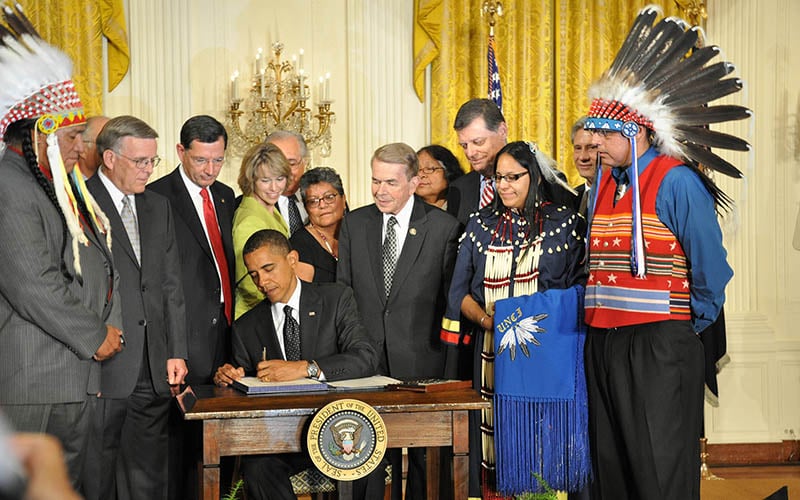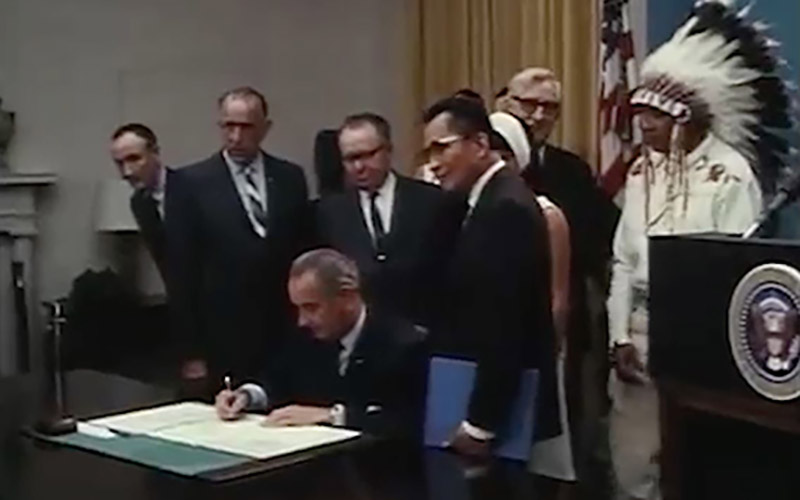
President Barack Obama signs the Tribal Law and Order Act in 2010, one of two laws that one expert called major victories for tribal courts looking to regain control of their laws and law enforcement. (Photo by National Congress of American Indians/Creative Commons)

A member of the Salt River Pima-Maricopa Indian Police Department on hand for the 2010 signing of the Tribal Law and Order Act. The bill helped tribal police regain some of the authority they had lost in recent decades. (Photo by National Congress of American Indians/Creative Commons)
WASHINGTON – In 1968, President Lyndon Johnson wrote Congress detailing the nation’s maltreatment of Native Americans, a people he described as an “alien in his own land.”
A month later, Congress made it official.
One part of the Indian Civil Rights Act of 1968 – signed by Johnson on April 11, 1968, just over a month after his letter to Congress – stripped tribes of the ability to impose more than a $500 fine and six months in prison for convictions in tribal courts.
That law was followed a decade later by a Supreme Court case that further restricted tribal sovereignty, ruling that tribes had no jurisdiction to prosecute non-Natives who commit crimes against Native victims.
Congress has only recently started to reverse those actions, but for most of the last 50 years tribal law enforcement had to refer any serious crime to federal or state law enforcement agencies with scant resources – and little interest, critics say – to investigate those crimes.
The FBI is “designed for much larger international crimes, interstate matters,” said Amy Hontalas, a professor at San Francisco State University. “They’re not designed for crimes that are typically handled by local governments.”
While their courts were shackled, Native Americans continued to be victims of crime at significantly higher rates than the rest of the nation. A Bureau of Justice Statistics report from 2016 said 13.3 Native Americans per 1,000 were victims of serious violent crime, almost twice the national average of 7.0 per 1,000 people.
“An alien in his own land”
What’s happened in the 50 years since President Lyndon Johnson called on Congress to enact sweeping programs to help Native Americans, people he called “the Forgotten American.”
And while that number may represent Native Americans nationwide, critics say it is likely higher on tribal lands, where the government has done a poor job of collecting crime data.
Under the Tribal Law and Order Act of 2010, the Bureau of Justice Statistics was ordered to put out an annual Indian Country crime report, something it has done every year since 2012. But the agency has conceded shortcomings in its report and said that while it is trying to develop a census for crime in the area, it has not been able to do so.
A 2017 report from the Justice Department’s Office of the Inspector General was highly critical of the department’s efforts to comply with the Tribal Law and Order Act, or TLOA.
“Seven years after TLOA became law, its data collection and reporting efforts are still in development,” the report said.
“Moreover, because participation in the FBI’s Uniform Crime Reporting (UCR) Program is voluntary, not all tribes report crime statistics into the UCR database. As a result, Indian country crime statistics are so outdated and incomplete as to be virtually useless,” the report said.
Hontalas agreed with the inspector general’s assessment, but said there are other problems with the data collection that are not being addressed.
“A lot of times people don’t differentiate between like, statistics for Native women in urban areas and statistics for Native women in rural areas, like reservations,” she said.
Despite the problems, Congress has made recent moves to reverse the restrictions of the ’60s and ’70s with bills like the Tribal Law and Order Act in 2010 and an expansion to the Violence Against Women Act in 2013.
Related stories:
 • Despite gains, Native American employment still lags behind nation
• Despite gains, Native American employment still lags behind nation
• Native Americans close the gap – almost – on U.S. life expectancy
• Lack of resources leads to ‘grim statistics’ in Native American schools
• Distance, language can still pose challenge to Native American voting
The TLOA increased the maximum sentence tribal courts could impose to a $15,000 fine and three years in prison, stackable to nine years.
And the 2013 reauthorization of VAWA allowed tribes for the first time in decades to prosecute non-Natives who commit acts of violence against Natives with whom they are in a relationship.
Both bills are seen as big strides for tribal sovereignty, but both have their issues. Tribal law enforcement officials in Arizona did not respond to request for comment on the laws, but Pascua Yaqui Chief Prosecutor Oscar Flores in March called the expansion of VAWA “a great first step” to restoring trust in tribal courts.
But the VAWA reauthorization so narrowly defined the crimes that can be prosecuted by tribal courts that it limited the effects of the law.
Under the law, only abuse against an established partner can be prosecuted by tribal law enforcement. That leaves tribal authorities unable to prosecute crimes such as stranger rape or child abuse committed by a non-Native against a Native American.
In addition to the restrictions, the only tribes that can prosecute non-Natives under the laws are those that meet certain requirements in their courts that effectively made them mirror state courts.
Despite the shortcomings, the laws are still major victories for tribal courts, Hontalas said.
“What happened in the 2013 reauthorization of the Violence Against Women Act, that was the first time that Native people gained back sovereignty from a federal law or policy since the 1800s,” she said. “This is extremely significant.”
Though Hontalas appreciates the steps Congress has taken in the last decade, she said that more often than not the government is the source of the problem not the solution.
“Passing additional federal laws to try and fix the problem that the United States itself created by ignoring its treaty obligation to people, I think, is in some ways an incorrect way to go about solving this problem,” she said.